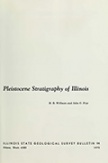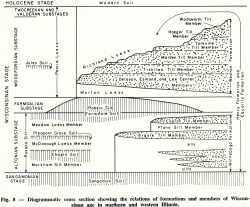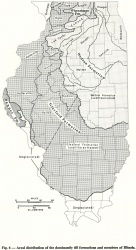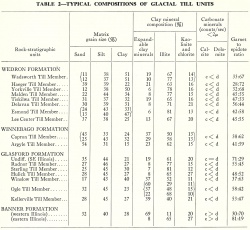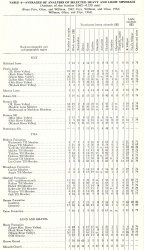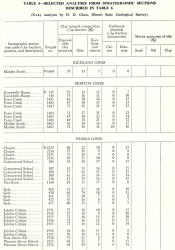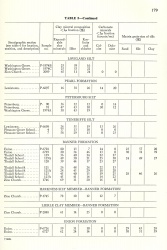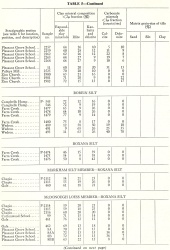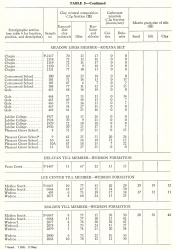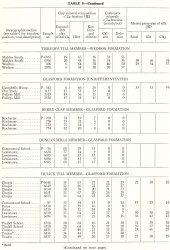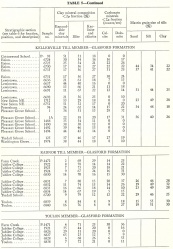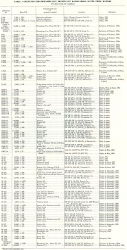Historical:Winnebago Formation
Lithostratigraphy: Winnebago Formation
Chronostratigraphy: Cenozoic Erathem >>Quaternary System >>Pleistocene Series
Authors
H. B. Willman and John C. Frye
Name origin
The Winnebago Formation was informally named Winnebago drift (Frye and Willman, 1960) for Winnebago County, as a replacement for the term Farmdale drift (Shaffer, 1956). The term was formalized as a formation in 1969 (Frye et al.).
Type section
The type locality was designated as the Rock Valley College Section and adjacent exposures and Northwest Tollway borings No. 2 and No. 5 (Kempton, 1963, p. 38). The type section is in the Rock Valley College Section, SW NW SW Sec. 10, T. 44 N., R. 2 E.
Stratigraphic relationships
The formation was defined to include those glacial deposits bounded by the Farmdale Soil at the top and the Sangamon Soil at the base.
It is subdivided into three named members: the Capron Till Member at the top, the Plano Silt Member below the Capron, and the Argyle Till Member below the Plano Silt. In the subsurface below the Argyle are silts, tills, and some outwash that have not been differentiated into members. The spatial relation of the Winnebago to adjacent stratigraphic units is shown diagrammatically in figure 8.
Extent and thickness
In the type section the Winnebago consists of 1.5 feet of Peoria Loess overlying 6 feet of leached till and 7 feet of calcareous, pink, sandy and cobbly till. The till is the Argyle Till Member of the Winnebago Formation. The Winnebago Formation probably is as much as 400 feet thick in the deeper bedrock valleys. The geographic distribution of the formation at the surface is indicated on the map in figure 6.
Lithology
The Winnebago Formation consists of tills, silts, peats, and outwash. The formation has been described in detail from deep core borings in Kane and McHenry Counties (Kempton, in Frye and Willman, 1965a), and its textural and mineral composition has been described (Frye et al., 1969).
Compositional data are given in tables 2, 4, and 5.
|
Age and correlation
Radiocarbon dates determined from the formation are listed in table 1.
The Winnebago Formation is entirely within the Altonian Substage of the Wisconsinan Stage. It is related largely to glacial advances from the Lake Michigan Lobe and possibly the Green Bay Lobe.
References
FRYE, J. C., H. D. GLASS, J. P. KEMPTON, and H. B. WILLMAN, 1969, Glacial Tills of Northwestern Illinois: Illinois State Geological Survey Circular 437, 47 p.
FRYE, J. C., and H. B. WILLMAN, 1960, Classification of the Wisconsinan Stage in the Lake Michigan Glacial Lobe: Illinois State Geological Survey Circular 285, 16 p.
FRYE, J. C., and H. B. WILLMAN, 1965a, [Illinois part of] Guidebook for field conference C—Upper Mississippi Valley (R. P. Goldthwait [organizer]; C. B. Schultz and H. T. U.
Smith [eds.]): International Association of Quaternary Research 7th Congress, Nebraska Academy of Science, p. 81-110; Illinois State Geological Survey Reprint 1966-B (supplemental data, J. P. Kempton and H. D. Glass, p. C-S1-C-S11), 41 p.
KEMPTON, J. P., 1963, Subsurface Stratigraphy of Pleistocene Deposits of Central-Northern Illinois: Illinois State Geological Survey Circular 356, 43 p.
SHAFFER, P. R., 1956, Farmdale drift in northwestern Illinois: Illinois State Geological Survey Report of Investigations 198, 25 p.
ISGS Codes
| Stratigraphic Code | Geo Unit Designation |
|---|---|
